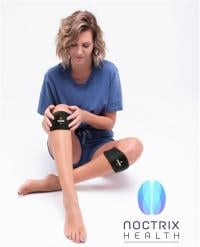Treatments for restless leg syndrome typically fall into two main categories, according to the Mayo Clinic: prescription medications—including opioids, muscle relaxants and drugs that increase dopamine levels—and external, topical treatments like warm baths, leg massages, foot wraps and more.
Noctrix Health aims to bridge that gap with a neurostimulation-based approach. Delivered via two bands worn around each leg overnight, the drug-free technology is designed to activate muscles in the legs to help reduce the symptoms and improve sleep quality, since the condition often flares up in the evening and at night, when individuals are sitting or lying down.
The wearables cater specifically to people whose restless leg syndrome hasn’t been effectively treated by pharmaceutical therapies—and now, those people will soon have access to Noctrix’s tech, thanks to a newly bestowed de novo clearance from the FDA.
In a company announcement Wednesday about the regulatory nod, CEO Shri Raghunathan said Noctrix is planning on bringing the neurostim system to the market “expeditiously.”

When the leg bands are worn just below the knee and activated, they send out electrical impulses targeting the peroneal nerves, which are responsible for movement and feeling in the lower leg and foot.
Noctrix has dubbed the technology its NTX100 Tonic Motor Activation system, highlighting the system’s continuous, sustained nerve stimulation—in contrast to phasic motor activation, which would send out shorter bursts of electricity.
The neuromodulation wearables have been on the FDA’s radar for several years now: In 2020, the regulator granted Noctrix its breakthrough device designation, recognizing the tech’s potential to fill an area of unmet need in healthcare and opening up a direct channel of communication between the company and the FDA.
In its announcement about the FDA clearance this week, Noctrix also shared that a randomized study of the technology had concluded in success. The trial recruited 133 people with moderate-to-severe, drug-refractory restless leg syndrome; for the first four weeks, they were split between using Noctrix’s wearables and a sham version of the system, after which all participants used Noctrix’s technology for another four weeks.
The study met all seven of its primary and secondary efficacy outcomes with statistical significance, according to Noctrix. The primary outcome measured how many of the participants saw their restless leg syndrome symptoms “much” or “very much” improved on the seven-point Clinical Global Impression – Improvement scale, while the six secondary outcomes factored in improvements in a handful of other scales, spanning self- and doctor-reported symptom severity, sleep quality and more.
Additionally, per Noctrix, none of the study participants experienced any significant adverse events after using the neuromodulation system.
“It is particularly impressive that use of this therapy resulted in enduring and clinically significant improvements in RLS symptom severity and sleep quality in a population of patients that suffer from severe RLS despite being on standard-of-care medications. The safety profile of this device only adds to its value proposition,” Richard Bogan, M.D., principal investigator of the study, said in the announcement.